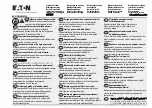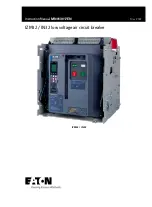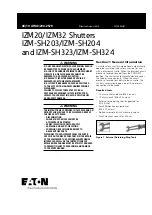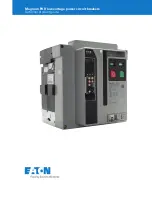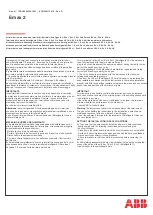
46
Types SDV-R and SDV-R-AR distribution circuit breakers |
Instruction manual
Insulation and contact-resistance test
procedure
1. Observe safety precautions listed in the
danger and caution advisories for the
vacuum integrity check tests.
2. Close the circuit breaker. Ground the
ground switch terminal and the circuit
breaker enclosure and ground each pole
not under test. Use manual charging,
closing and tripping procedures.
3. Apply 60 kV ac rms or 85 dc high-
potential test voltage between a primary
conductor of the circuit breaker pole and
ground for one minute.
4. If no disruptive discharge occurs, the
insulation system of the circuit breaker is
satisfactory.
5. After test completion, ground both ends
of the vacuum interrupters and the arc
chamber of each vacuum interrupter to
dissipate any static charges.
6. Open the circuit breaker. Ground the
circuit breaker terminal and frame of the
circuit breaker enclosure and ground
each pole not under test.
7. Apply 60 kV ac rms or 85 dc high-
potential test voltage between a primary
conductor of the ground switch pole and
ground for one minute.
8. If no disruptive discharge occurs, the
insulation system of the ground switch is
satisfactory.
9. After test completion, ground both ends
of the vacuum interrupters and the arc
chamber of each vacuum interrupter to
dissipate any static charge.
10. Disconnect the leads to the spring-
charging motor.
11. Disconnect secondary circuits for the
operating mechanism by disconnecting
the multiple pin-plug and connect all
pins on the operator side with a shorting
wire. Connect the shorting wire to the
high-potential lead of the high-voltage
tester and ground the circuit breaker
enclosure.
12. Starting with zero voltage, gradually
increase the test voltage to 1,500 volts
rms, 60 Hz. Maintain test voltage for one
minute.
13. If no disruptive discharge occurs, the
secondary control insulation level is
satisfactory.
14. Disconnect the shorting wire, reattach
the multiple pin-plug, and reattach the
leads to the spring-charging motor.
15. Perform contact-resistance tests of the
primary contacts of both the circuit
breaker and ground switch circuits. The
resistance should not exceed 30 micro-
Ohms between the fixed-end connection
pad and the moving-end connection pad
of the circuit breaker circuit and
60 micro-Ohms between the fixed-end
connection pad and the moving-end
connection pad of the ground switch
circuit (refer to Figure 9 on page 23).
Inspection and cleaning of circuit breaker
insulation
1. Perform the spring-discharge check on
the circuit breaker. The spring-discharge
check consists of:.
• De-energize control power.
• Press red open/trip button on the
operating mechanism.
• Press black close button on the operating
mechanism.
• Again press red open/trip button on the
operating mechanism.
• Verify spring-condition indicator shows
DISCHARGED.
• Verify main contact status indicator
shows OPEN.
• All controls are on the circuit breaker
front panel (refer to Figure 9: Operator
panel controls of circuit breaker and
manual charging of closing on page 23
and manual charging of closing springs
on. Visually verify the discharged
condition of the springs.
2. Clean barriers and post insulators using
clean cloth and isopropyl alcohol.


























